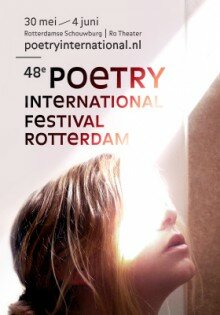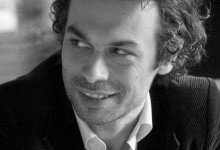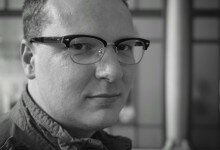Beyond the Avant-Garde and Expressionism
During his lifetime Srecko Kosovel published no more than forty-odd poems, but nevertheless became one of the few canonised Slovene poets and one of the most praised and prominent representatives of the Slovene "historical avant-garde". The canonisation of his work is intricate and has some unexpected twists. At first it seemed that he would enter the history of Slovene literature primarily as an impressionistic poet of the Slovene Karst, the Slovene hinterland of the Italian-Austrian-Slovene metropolis of Trieste, or perhaps as an expressionistic poet, proclaiming the destruction and cataclysm of Europe. Since many of his poems were interpreted as revealing the hardships of the Slovene population under Italian rule, he also become one of the icons of Slovene resistance against Italian and German occupying forces in the Second World War, when even a partisan brigade and a choir were named after him. This image of a young poet sensible to the suffering and struggle of the Slovene population for survival under foreign rule has been kept alive, so that today schools, public libraries and arts centres carry his name. In the late sixties though, Srecko Kosovel stirred up the-Slovene public again; this time he was praised, especially by the young Slovene neo-avant-garde, for the poetic exploration and innovation found in his lntegrali (integrals) published for the first time 41 years after his death. In fact, a group of Slovene poets not only admired his work but found in him their contemporary, the founder of their poetics in retrospect.
During his lifetime Srecko Kosovel (1906 - 1926) published no more than forty-odd poems, but nevertheless became one of the few canonised Slovene poets and one of the most praised and prominent representatives of the Slovene "historical avant-garde". The canonisation of his work is intricate and has some unexpected twists. At first it seemed that he would enter the history of Slovene literature primarily as an impressionistic poet of the Slovene Karst, the Slovene hinterland of the Italian-Austrian-Slovene metropolis of Trieste, or perhaps as an expressionistic poet, proclaiming the destruction and cataclysm of Europe. Since many of his poems were interpreted as revealing the hardships of the Slovene population under Italian rule, he also become one of the icons of Slovene resistance against Italian and German occupying forces in the Second World War, when even a partisan brigade and a choir were named after him. This image of a young poet sensible to the suffering and struggle of the Slovene population for survival under foreign rule has been kept alive, so that today schools, public libraries and arts centres carry his name. In the late sixties though, Srecko Kosovel stirred up the-Slovene public again; this time he was praised, especially by the young Slovene neo-avant-garde, for the poetic exploration and innovation found in his lntegrali (integrals) published for the first time 41 years after his death. In fact, a group of Slovene poets not only admired his work but found in him their contemporary, the founder of their poetics in retrospect.
The abrupt changes in the reception of Kosovel's work could by explained by the unusual history of the publication and editing of his work which was caused by his premature death. Kosovel was born in 1904 in Se?ana, in the littoral region of the territory populated by Slovenes which at that time belonged to Austria-Hungary. He never forgot the landscape of his youth, which he experienced and described as an idyll. However, his family decided that Srecko should go to secondary school in Ljubljana, where he witnessed all the tumultuous changes following the First World War. After the defeat of the Austro-Hungarian Empire in World War I, the Kingdom of the Serbs, Croats and Slovenes was formed in December 1918, joining the Kingdom of Serbia, Montenegro and the South Slav territories of Austria-Hungary, i.e. also the territory of the present-day Republic of Slovenia, into a new state. Though reserved towardthe Belgrade politicians, the Slovenes welcomed the new state as a defence against Italy, which took upon itself the role of the chief power in southern Europe. However, they were bitterly disappointed when the treaty of Rapallo in 1920 fixed a frontier leaving several hundred thousand Slovenes under Italian rule, among them the Kosovel family. The Slovene population in that area was soon subjected to strong Italian political and cultural pressures. The Kosovel family felt all the consequences of the intense Italianization; Srecko's father, a school teacher, lost his job, and was forced to retire, so that the family was left without any resources for a year. Srecko Kosovel thus soon recognised all the dangers that the growing fascism represented for Slovenes in Italy. In 1922 he started his Studies at the Faculty of Arts in Ljubljana, taking Romance and Slavonic languages and philosophy. He became involved in many literary activities, contributed to different literary magazines, and set up one of his own called "Lepa Vida" which unfortunately soon went bankrupt. With his friends he wanted to found new literary magazines line with the new poetic and artistic trends and a publishing house for proletarian writers. But all his plans came to a halt when, in February 1926, he caught a cold; his illness worsened, developed into meningitis, and in May 1926 Srecko Kosovel died at the age of 22.
In only four extremely prolific years (1923-1926) Srecko Kosovel created more than one thousand poems which were left in manuscript and a couple of hundred prose works consisting of lyrical prose and sketches, literary criticism and essays on cultural problems, notes, diaries and letters. This relatively large corpus made editing quite difficult, especially because the material also varied in style and poetics. In summer 1923 Kosovel did mention in his letters that he was preparing a collection Zlati coln (The Golden Boat), deliberately alluding to the collection of poems by Rabindranth Tagore; however, he never mentioned the titles of the poems he intended to include in it. Thus, the selection and classification of his work was left entirely to his editors. The first collection of 60 poems Pesmi (Poems) was published in 1927, a year after Kosovel's death, by his friend, Alfonz Gspan. Four years later, in 1931, Anton Ocvirk, who then became the chief editor of his work, published lzbrane pesmi (Selected Poems). Both collections were flawed since they somehow uncritically relied on the printed versions of the published poems, including editorial changes and "improvements" to the manuscript versions. In 1946 the first volume of Kosovel's Zbrano delo (Collected Works) appeared, edited by Anton Ocvirk. More than 170 of what he called "constructive" poems were left out, because the editor considered them as rough sketches full of topical political and ideological issues and therefore not interesting to the post-war readership. His views concerning this part of Kosovel's work, however, changed radically over the years. In 1964, when Ocvirk published a revised edition of the first volume of Collected Works he changed his mind completely; he had re-evaluated Kosovel's avant-garde works, and promised to publish the poems that were left out in the second volume. However, in 1967, 41 years after Kosovel's death, Ocvirk decided not to publish those poems in Collected Works, but in a separate edition, giving them the title lntegrali '26 (Integrals) — the edition was one of the most exciting literary events of that time. Slovene modernist poets found in this portion of Srecko Kosovel's work a missing part of Slovene literary history. Kosovel became their forerunner in retrospect, a revolutionary modernist, their "older contemporary", a poet with whom they felt they shared a horizon of understanding and poetic expression. The edition itself, however, was severely criticised by some literary critics for not being an accurate transcript of manuscript versions. Thus in 1974 the second volume of Collected Works appeared containing a revised version of Integrals, followed by the third and the last part (in two volumes) in 1977, containing Kosovel's prose works, letters and notes. Thus by the end of the 70's, more than $0 years after the poet's death, the majority of Srecko Kosovel's work was finally available to the general reading public.
Traditionally, Kosovel's corpus was classified into three chronological phases: impressionism, expressionism and constructivism. However, later research of the manuscripts revealed that no linear development could be traced, and that all three phases seemed to have coincided; in fact, Kosovel's creativity developed spirally. Nonetheless, the editor, Anton Ocvirk, had to organise the material according to some criteria, and therefore decided on a selection according to the motifs in the poems. Thus Integrals contained poems not belonging to Kosovel's "impressionistic and expressionistic phase". The editor formed four thematic clusters: the first focussing on antagonisms in Europe, the second on the fate of Slovenes threatened by foreign rule, the third on Kosovel's new lyrical poetry, and the last on chaos and the cosmos permeated with constant visions of death. In spite of the editor's conviction that the poems selected in Integrals were purely "constructivist", the collection revealed an essentially syncretic nature: the basic expressionistic elements were blended with dadaist, surrealist and explicitly futurist elements. The editor's choice for the term "constructivism" stems from the fact that Kosovel himself in an article written in 1923/26 referred to his new writings as constructivist; however, his poetry could hardly be defined as pertaining entirely to this current of the Russian avant-garde. While his diary-entries and other texts show that he was familiar with the terms impressionism, expressionism, futurism and dadaism, he seemed to be acquainted with little more than the basics of constructivism and thus understood this word largely in his own way. Russian constructivism (1923-1930), which first emerged among Russian painters around 1913 and included such artists as VladimirTatlin and Naum Gabo, called for a union of art with science and technology. Kosovel seemed to have known some theoretical writings by llja G. Erenburg, published in the literary magazine Zenit, but not the others. Gradually, the movement's ideas spread to literature, and in 1924 a group of Russian writers organised under the banner of constructivism called for the absorption of the lexicon of science and technology by literature: these included the poets Ilija Selvinskij, Eduard Bagritskij, Vera Inber and the movement's theoreticians K. L. Zelinskij and A. N. Cicerin. The group's theories were hazy at best and, with the exception of Selvinskij, little more than lip service was paid to them. Constructivism thus seemed to have been mainly if not exclusively influential in the visual arts, in particular painting, and did not achieve much in the field of literature. In fact, no research has yet succeeded in proving a direct link between Kosovel and constructivism; however, two intermediaries have been established: the first was his friend Avgust Cernigoj, a Slovene painter, who studied in Germany and informed Kosovel about the "Bauhaus" movement, and Ljubomir Micic, the editor of the literary magazine Zenit, where an echo of constructivist theses could be found in a fragmented and vague way. Micic started Zenit in Zagreb (1 Feb 1921), and then continued to publish it in Belgrade from 1923 tight up to its prohibition in December 1926. The last issue, no. 43, was banned because of its pronounced left-wing, Marxist orientation. Zenit published prose, poetry and artistic programs in Serbo-Croatian, Slovene, Hungarian, German, Czech, French, English, Flemish, Russian, Bulgarian, Italian, Spanish, even Esperanto, written by the most distinguished avant-gardists in Europe. It had extended collaboration with similar reviews in Europe and managed to create a movement which covered the whole spectre of European avant-garde movements, from expressionism through futurism,dadaism to surrealism. However, when Micic "expelled" dadaism and surrealism from Zenit, and started using the term constructivism to denote his blend of expressionism and futurism, Kosovel most probably followed his path and seemed to have, because of lack of information, identified zenitism with constructivism. Moreover, the term constructivism was appealing to Kosovel not only because in his eyes it expressed a blend of expressionist, futurist and dadaist elements typical of zenitism, but because it could also be used in an ethical sense to signify the constructing of a relationship of harmony among people, one of the basic expressionist messages of Kosovel's poetry. Kosovel's expressionism was contradictory complex, like the movement itself. He sensed aprofound crisis in the "old order", which resulted in recurrent premonitions that Europe, unawares, was on the verge of cataclysm. The madhouse of Europe had no chance for development, according to Kosovel. Only the destruction of the old Europe and a new form of humanism could open the door to the new world, which could be conceived of only in the future and only as a humane one. Contrary to the futurist spirit of optimism about the progress of the times, he considered the world as a "negative total", a totality of negativity. However, he believed that literature and culture in general could and would transform it into a positive form. Sometimes his anxieties and frustrations were revealed in an aggressive hostility towards his homeland, sometimes in visions of death and destruction; however, there was an alternative, where he expressed a messianic utopianism that burst forth in appeals to the spirit of universal brotherhood.
Kosovel added to this expressionist base in many ways contradictory futurist elements. Although after the First World War futurism in Italy was in decline, and "primary" or "heroic" futurism came to an end around 1920, the periphery (and Slovene and Croat territories were undoubtedly peripheral to Italy) kept futurism alive for another decade. Futurism was thus not new to Kosovel, he knew the poetry of Anton Podbevsek, a representative of the first generation of the Slovene avant-garde, and he was also considerably well-acquainted with Italian futurism and its militant promotion of extreme artistic innovation andexperimentation. While he adopted many of the formal innovations proposed by the movement, he did not agree with the ontological principles underlying it. Italian futurism rejected psychological sensitivity, the lyricism of symbolism and traditionalism; it called for the demolition of all institutions concerned with preserving the past; it glorified the present, exalted speed, dynamism, power, violence, war and the beauty of machinery. And indeed Kosovel used many features of futurist poetics in his poetry such as the idea of the destruction of museums, libraries and academies; MAS (motoscafo d'assalto) as a torpedo boat often used in futurist symbolism, automobiles, electricity, etc. He also used the poetical innovations enunciated by futurism and its main protagonist Filippo T. Marinetti: he applied the principle of parole in liberta (words in freedom), i.e. the use of language free of syntax and logical ordering, which was supposed to convey intense emotion rapidly, and the principle of analogia disegnata (pictorialized analogy) which involvedmaximum freedom of imagery and metaphor. This led him to the expressive use of typography, with fonts of various sizes, styles and colours being used in the same line or word and the free disposition of words on the printed page, sometimes resembling a typographic collage. He used cacophonic onomatopoeias, mathematical symbols and equations, functioning as coded metaphors, and reached the final stage of experimentation with poetic form in creating newspaper collages and geometrical pictures functioning as part of a poetic artefact. However, Kosovel did not adopt all of the tenets pertaining to this movement; he never made a complete break with the past and its traditions. The poet also had another reason for avoiding the term "futurism": he was repelled by the movement's political orientation towards Mussolini and fascism, so any association of his poetry with futurism would offend his strongly expressed patriotism, especially after events in the 1920's when in Trieste the Italian fascists burnt down the "Slovene Cultural Centre" and the "Edinost" printing works, and vandalised several Slovene buildings.
Kosovel's corpus is thus marked by this fundamental duality between expressionism and avant-garde futurism, with dadaist and surrealist elements, by the oscillation between the "avantgarde" and "traditionalism", which remained the essential characteristic of his poetry up to his death. However, while Integrals is part of the European avant-garde, futurism, zenitism, constructivism, dadaism, surrealism and expressionism, at the same time Kosovel's poetry does not belong to any of these currents exclusively. His work does not allow itself to be explicitly located, since the poet did not blindly follow the precepts of any of these schools; and precisely this resistance to classification discloses the specific character of his creativity. Indeed, the uniqueness of Integrals, lies in what cannot be defined, in what escapes and transcends every attempt at clear-cut classification. No critical discussion can replace the poems themselves, which have to be read in order to reveal their hidden potential.






